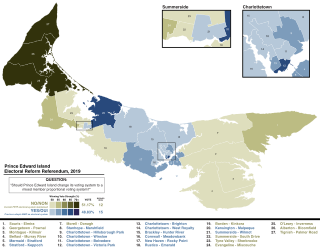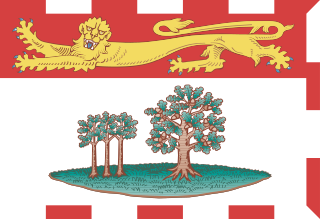National referendums are seldom used in Canada. The first two referendums saw voters in Quebec and the remainder of Canada take dramatically opposing stands, the third saw most of the voters take a stand dramatically opposed to that of the politicians in power.
Mixed-member proportional (MMP) representation is a mixed electoral system in which voters get two votes: one to decide the representative for their single-seat constituency, and one for a political party. Seats in the legislature are filled firstly by the successful constituency candidates, and secondly, by party candidates based on the percentage of nationwide or region-wide votes that each party received. The constituency representatives are elected using first-past-the-post voting (FPTP) or another plurality/majoritarian system. The nationwide or region-wide party representatives are, in most jurisdictions, drawn from published party lists, similar to party-list proportional representation. To gain a nationwide representative, parties may be required to achieve a minimum number of constituency candidates, a minimum percentage of the nationwide party vote, or both.
Canada holds elections for legislatures or governments in several jurisdictions: nationally (federally), provincially and territorially, and municipally. Elections are also held for self-governing First Nations and for many other public and private organizations including corporations and trade unions. Municipal elections can also be held for both upper-tier and lower-tier governments. Formal elections have occurred in Canada since at least 1792, when both Upper Canada and Lower Canada had their first elections.
The Citizens' Assembly on Electoral Reform was created by the government of British Columbia, Canada to investigate changes to the provincial electoral system. On 25 October 2004, it proposed replacing the province's existing first past the post (FPTP) system with BC-STV, a single transferable vote (STV) system. This recommendation was put to the electorate-at-large in a referendum held concurrently with the 2005 provincial election. In order for the results to be binding, the referendum required a super-majority including approval by 60% of voters overall and simple majorities in 60% of the 79 districts in order to pass. In the event, the second of these thresholds was easily met, with a majority supporting the reform in 77 out of 79 electoral districts, but the overall vote fell short of the 60% requirement, with 57.7% of the votes in favour.

A referendum was held in the Canadian province of British Columbia on May 17, 2005, to determine whether or not to adopt the recommendation of the Citizens' Assembly on Electoral Reform to replace the existing first-past-the-post electoral system (FPTP) with a single transferable vote system (BC-STV). It was held in conjunction with the BC Legislative Assembly election of 2005. Voters were given two ballots at that time: a ballot to vote for a Member of the Legislative Assembly of British Columbia (MLA) in their constituency and a referendum ballot. The referendum received considerable support from the electorate but failed in meeting the demanding threshold that had been set. A second referendum was held in 2009.
The Citizens' Assembly on Electoral Reform was established by the government of the province of Ontario, Canada in March 2006. Modelled on the British Columbia equivalent, it reviewed the first past the post electoral system currently in use to elect members of the Ontario Legislature, with the authority to recommend an alternative. In May 2007, the Assembly recommended, by a decision of 94-8, that Ontario adopt a form of mixed member proportional representation (MMP).

An Ontario electoral reform referendum was held on October 10, 2007, on the question of whether to establish a mixed member proportional representation (MMP) system for elections to the Legislative Assembly of Ontario. However, the resulting vote was strongly in favour of the existing plurality voting or "first-past-the-post" (FPTP) system.
The Electoral Reform Coalition (ERC) is a group advocating electoral reform in New Zealand. It was founded in 1986. The group has been reformed as the Campaign for MMP to fight to retain Mixed-member proportional representation at the 2011 referendum on the issue.
The following tables are the detailed results of the Ontario electoral reform referendum that was held on October 10, 2007, in an attempt to establish a mixed member proportional representation (MMP) system for elections to the Legislative Assembly of Ontario. However, the vote went heavily in favor of the existing plurality voting or "first-past-the-post" (FPTP) system.

Mississauga South was a provincial electoral district in Ontario, Canada, that has been represented in the Legislative Assembly of Ontario since 1975.

The 2019 Prince Edward Island general election was held to elect the 27 members of the 66th General Assembly of Prince Edward Island in Atlantic Canada. The election in 26 of the electoral districts was held April 23, 2019, while the vote in Charlottetown-Hillsborough Park was cancelled due to the death of the Green party's candidate, with a by-election to be held no later than July 19, 2019.
Dual-member proportional representation (DMP), also known as dual-member mixed proportional, is an electoral system designed to produce proportional election results across a region by electing two representatives in each of the region’s districts. The 1st seat in every district is awarded to the candidate who receives the most votes, similar to first-past-the-post voting (FPTP). The 2nd seat is awarded to one of the remaining district candidates so that proportionality is achieved across the region, using a calculation that aims to award parties their seats in the districts where they had their strongest performances.
The 2016 Plebiscite on Democratic Renewal was a non-binding referendum on electoral reform held in the Canadian province of Prince Edward Island between 27 October – 7 November 2016. This was the second electoral reform referendum to be held in Prince Edward Island, following a vote to maintain the status quo in 2005. The referendum asked which of five voting systems residents would prefer to use in electing members to the Legislative Assembly of Prince Edward Island. The referendum, after four instant run-off rounds, indicated mixed member proportional representation was the preferred choice with 55.03% support on the final ballot.

The 42nd British Columbia general election will be held on or before October 16, 2021, to elect members of the Legislative Assembly in the Canadian province of British Columbia.
A mixed electoral system is an electoral system that combines a plurality/majoritarian voting system with an element of proportional representation (PR). The plurality/majoritarian component is usually first-past-the-post voting (FPTP), whereas the proportional component is most often based on party list PR. A distinguishing characteristic of mixed systems is the fact that every voter can influence both the plurality/majoritarian and PR aspects of an election. In a hybrid system, by contrast, different electoral formulas are used in different regions of a country.

A referendum on electoral reform took place by mail-in ballot between October 22 and December 7, 2018, in the Canadian province of British Columbia. This was British Columbia's third referendum on electoral reform since 2005.

Rural–urban proportional representation (RUP), also called Flexible District PR, is a hybrid proportional system designed by Fair Vote Canada with the intention of meeting the special challenges of Canada's geography, which includes wide-flung, sparsely-populated areas. As conceived in general terms by Fair Vote Canada, the rural–urban proportional model combines the use of multi-member ridings and top-up seats to meet the different needs of both rural and urban areas, while protecting the objective of proportionality. Sweden, Denmark and Iceland use similar voting models.

A referendum on electoral reform was held on April 23, 2019 in the Canadian province of Prince Edward Island – simultaneously with the 2019 provincial election – to determine if the province should adopt a mixed-member proportional representation voting system (MMP). The referendum was not binding, as neither option received majority support in 60% or more of the province's 27 electoral districts, however the popular vote was a narrow majority in favour of keeping the existing first-past-the-post system.










